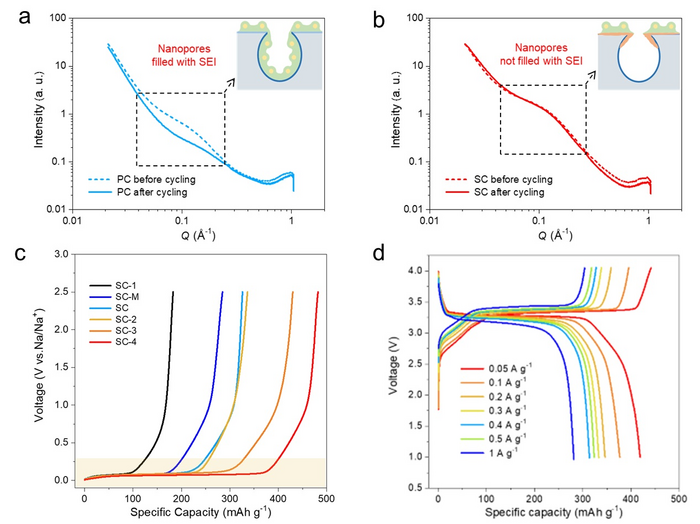Reviewed by Alex SmithJul 4 2022
The advancement of large-scale energy storage devices with flexibility, high energy conversion efficiency, and easy maintenance is urgently needed due to the exponentially expanding application of solar energy systems, such as wind and solar energy.
 Small angle X-ray scattering patterns of (a) porous carbon (PC) and (b) SC anodes before and after (dashed line) 5 full cycles at a current density of 50 mA g-1. Inset: the relative location of the SEI to the nanopores. The SEI is a green irregular shape with yellow solid circles (sodium ions) inside. (c) 1st-cycle charge curves of different SCs at a current density of 50 mA g-1. (d) Charge/discharge curves of a Na3V2(PO4)3//SC-3 full cell from 0.05 A g-1 to 1 A g-1. Image Credit: Science China Press
Small angle X-ray scattering patterns of (a) porous carbon (PC) and (b) SC anodes before and after (dashed line) 5 full cycles at a current density of 50 mA g-1. Inset: the relative location of the SEI to the nanopores. The SEI is a green irregular shape with yellow solid circles (sodium ions) inside. (c) 1st-cycle charge curves of different SCs at a current density of 50 mA g-1. (d) Charge/discharge curves of a Na3V2(PO4)3//SC-3 full cell from 0.05 A g-1 to 1 A g-1. Image Credit: Science China Press
Since sodium reserves are naturally abundant and inexpensive, sodium-ion batteries (SIBs) have lately attracted significant interest from both the academic and business worlds as a sustainable alternative to lithium-ion batteries (LIBs).
The most promising SIB anode possibilities are non-graphitic carbons. The question of the perfect carbon anode for SIBs — which functions in a similar manner to graphite in lithium-ion batteries — and how to rationally design the optimal carbon anodes are crucial, but they are still poorly understood due to the diverse and complex microstructures of these batteries. The commercialization of SIBs is unavoidably hampered by this.
As the practical anodes for high-energy SIBs with extensible and reversible low-potential charge/discharge plateaus (LPPs, < 0.1 V vs. Na+/Na), sieving carbons (SCs) with highly tunable nanopores and tightened pore entrance were proposed in a recent study led by Prof. Quan-Hong Yang, Dr. Jun Zhang (Tianjin University), and Prof. Yong Yang (Xiamen University).
According to this study, the narrow pore entrance width (<0.4 nm) contributed to the production of the solid electrolyte interphase (SEI). The SEI was mostly formed outside the nanopores and helped to screen out the solvated sodium ions.
It was observed that bare sodium ions initially adsorbed on the flawed pore surface, then aggregated to eventually create quasi-metallic sodium clusters inside nanopores by employing SCs as the perfect carbon models for examining the process connected to the LPPs.
A record-breaking plateau capacity of 400 mAh g–1 was achieved due to the spectroscopic and theoretical analyses that demonstrated an essentially linear link between the specific surface area in SCs and the plateau capacity.
It was further demonstrated that a pore body diameter with an upper limit (~2.0 nm) ensures the reversibility of the LPPs, which is essential for improving the cycle stability of SC anodes.
The proposed method of making SCs was more encouraging as it could be scaled up to transform commercial porous carbons into useful anode materials, opening the door for the quick commercialization of SIBs.
The proposed sieving carbons is a conceptual advance for the carbon anode design for high-energy SIBs, and potential to play a similar role to what graphite does in lithium-ion batteries. The structural tunability makes sieving carbons also promising for practical use in high-energy or high-power lithium-ion batteries, potassium-ion batteries, and so on.
Prof. Quan-Hong Yang, Tianjin University
Journal Reference:
Li, Q., et al. (2022) Sieving carbons promise practical anodes with extensible low-potential plateaus for sodium batteries. National Science Review. doi:10.1093/nsr/nwac084.